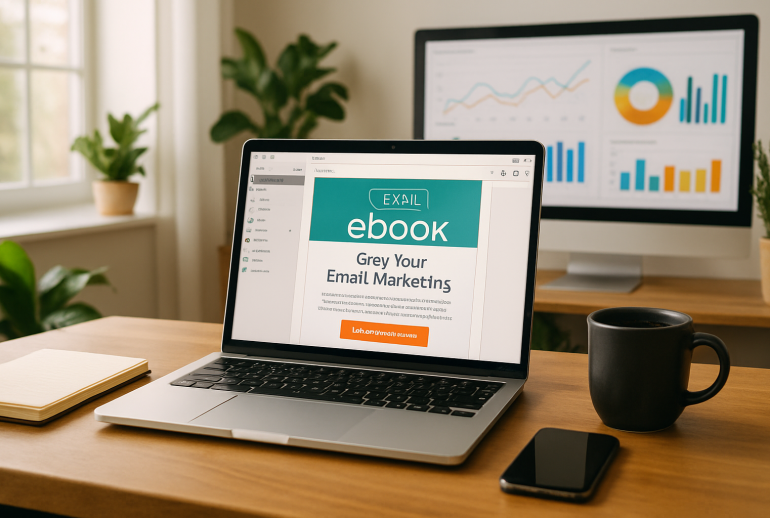In the ever-evolving digital landscape of 2025, email marketing remains a cornerstone strategy for authors seeking to promote their ebooks effectively. As the ebook market continues its upward trajectory, harnessing the power of email campaigns not only fosters direct communication with potential readers but also significantly amplifies reach and conversion rates. Savvy authors understand that while creating excellent content is vital, deploying tailored email marketing tactics can dramatically elevate their ebook’s visibility and sales potential. This approach integrates carefully segmented mailing lists, personalized messaging, and strategic campaign flows crafted using tools like Mailchimp, ConvertKit, or ActiveCampaign. The convergence of these methods transforms passive subscribers into engaged readers and loyal advocates.
At its core, email marketing offers a unique advantage: it bypasses the unpredictability of social media algorithms and delivers your message directly into inboxes where recipients have already expressed interest. By constructing a robust email funnel—beginning with enticing lead magnets like free chapters or exclusive insights—you can build a qualified list primed for conversion. Platforms such as Constant Contact, GetResponse, and Sendinblue further enhance this process by offering automation features, analytics, and segmentation capabilities optimized for diverse audiences. In an environment saturated with content, well-orchestrated email marketing campaigns enable your ebook to not only compete but thrive.
This comprehensive guide explores the strategic use of email marketing to not just promote your ebook, but to create lasting reader relationships and sustainable income streams. From setting up your email service provider to designing engaging campaigns with tools like HubSpot and Campaign Monitor, to implementing affiliate link integration and split testing, each facet plays a crucial role in maximizing ebook success. Moreover, integrating email marketing with other outreach channels like blogging and social media expands your promotional footprint, crafting a coherent omnichannel presence.
Mastering Email List Building Techniques for Ebook Promotion
Building a quality email list is foundational to leveraging email marketing effectively for your ebook. Without a carefully curated audience, your best-crafted messages might never reach interested readers. The starting point is attracting subscribers who resonate with your ebook’s content and are genuinely interested in what you offer.
One proven method is offering a compelling lead magnet—a free chapter, checklist, or a resource closely aligned with your ebook topic—in exchange for contact information. This incentive encourages opt-ins while filtering for relevance. For example, if your ebook focuses on affiliate marketing strategies, providing a free guide titled “Top 10 Email Marketing Tools for Affiliates” effectively attracts the right segment.
To optimize list building, consider these approaches:
- Landing Pages: Create dedicated pages with headline clarity, persuasive copy, and an unmistakable call-to-action. These pages should be streamlined, focusing on lead capture without distractions. Tools like this guide on lead magnets for ebooks demonstrate how to build effective landing pages.
- Content Upgrades: Enhance blog posts related to your ebook topic with downloadable extras, enticing readers to subscribe for bonus content. Tailor upgrades to each post’s focus, improving conversion quality.
- Social Media Integration: Leverage your profiles strategically by sharing snippets, including direct landing page links, or hosting live Q&A sessions to funnel followers into your mailing list.
- Collaborations: Partner with influencers or complementary brands to co-promote your lead magnets, broadening exposure. Sharing lists or hosting joint webinars can multiply results.
Employing professional email marketing platforms such as ConvertKit, known for creator-friendly automation, or AWeber, with its proven deliverability rates, ensures your subscriber data is managed efficiently and your emails land in inboxes. Integrating these platforms with tools that automate segmentation (based on user behavior or demographics) enables sending personalized messages that foster higher engagement.
| List Building Method | Advantages | Example Tools |
|---|---|---|
| Lead Magnets (e.g., free chapter) | Attracts qualified and engaged subscribers | ConvertKit, GetResponse |
| Landing Pages | Focused conversion funnel, higher opt-in rates | Mailchimp, Campaign Monitor |
| Content Upgrades | Improves conversion on existing content | AWeber, ActiveCampaign |
| Social Media Campaigns | Engages wider audience, drives targeted traffic | HubSpot, Sendinblue |
| Collaborations & Partnerships | Broader reach, credibility from endorsements | Drip, Constant Contact |
By combining these techniques with a nuanced understanding of your audience’s preferences and online behavior, your email list becomes a powerful asset. Curious about how email marketing integrates with SaaS sales funnels? Explore detailed insights here.
Crafting Irresistible Email Campaigns that Convert for Your Ebook
Designing email campaigns that resonate with your audience demands a balance between creativity and data-driven tactics. Your email’s content must be informative, engaging, and focused sharply on driving subscribers toward downloading or purchasing your ebook.
Begin with compelling subject lines. These should evoke curiosity, urgency, or promise clear benefits. Incorporate power words like “exclusive,” “free,” or “limited-time” to boost open rates. Split testing subject lines with platforms such as Mailchimp or HubSpot helps identify the most effective phrasing.
Your email body should:
- Emphasize Value: Clearly articulate the benefits readers gain, whether knowledge, skills, or problem-solving insights, supported by genuine examples or testimonials.
- Use Engaging Visuals: Integrate your ebook cover, infographics, or short videos to enhance interest and break up text.
- Include Clear Calls to Action (CTA): Position clickable buttons or links prominently, urging actions like “Download Your Free Chapter” or “Get the Ebook Now.”
- Segment and Personalize: Tailor messages based on subscriber behavior, such as prior engagement or purchase history. For instance, use Constant Contact or Sendinblue for dynamic content blocks that adapt to user profiles.
An effective campaign might have a sequence such as:
- Launch Announcement: Introducing the ebook with an engaging overview and download link.
- Follow-up Value Email: Sharing tips or exclusive excerpts that highlight the book’s value.
- Limited-Time Offer: Creating urgency with a discount or bonus for early buyers.
- Last Chance Email: Reminding subscribers before the promotion ends.
Examples of top-tier email marketing platforms that support such campaigning include GetResponse for advanced automation, ActiveCampaign for behavior-triggered workflows, and Drip for ecommerce-focused strategies. Testing different send times, subject lines, and CTAs also informs continual improvement.
Effective email marketing directly impacts your ebook sales funnel, supporting lead nurturing, customer retention, and repeat purchases. For more on optimizing these funnels, read this expert guide.
Integrating Affiliate Marketing and Email Campaigns to Maximize Ebook Revenue
Affiliate marketing presents a powerful complement to email marketing in amplifying ebook sales. By recruiting affiliates who promote your ebook to their audiences, you extend reach and leverage established trust networks. When combined with email marketing, affiliate promotion becomes a scalable income source.
Successful integration involves:
- Setting Up Affiliate Programs: Utilize platforms such as ClickBank or ShareASale to manage affiliates, track sales, and distribute commissions.
- Providing Affiliates with Ready-Made Email Content: Supply swipe emails, graphics, and promo links that affiliates can easily deploy to their lists.
- Exclusive Email Offers: Work with affiliates to create unique discount codes or bonuses, incentivizing purchases through email campaigns.
- Regular Communication: Keep affiliates engaged via newsletters and performance updates using tools like Campaign Monitor or ConvertKit.
Integrating affiliate marketing with your own email campaigns enhances credibility and offers multiple consumer touchpoints. For authors looking to monetize their marketing efforts broadly, affiliate marketing strategies are expertly explored in resources such as this comprehensive overview.
| Affiliate Marketing Integration Steps | Benefits | Recommended Platforms |
|---|---|---|
| Affiliate Program Setup | Scalable promotion through partner networks | ClickBank, ShareASale |
| Affiliate Email Swipes | Consistent messaging and easier promotion | ConvertKit, Campaign Monitor |
| Exclusive Offers for Email Subscribers | Higher conversion through incentives | ActiveCampaign, AWeber |
| Ongoing Affiliate Engagement | Increased motivation and sales | Drip, HubSpot |
Utilizing Analytics and Automation to Optimize Your Ebook Email Marketing Campaigns
Data-driven decision-making and automation elevate email marketing from guesswork to a precise science. By analyzing subscriber behavior and automating repetitive tasks, you optimize campaign ROI and reader experience simultaneously.
Start using comprehensive analytics to track:
- Open Rates: Gauge the effectiveness of subject lines and send times.
- Click-Through Rates (CTR): Understand which links and calls-to-action resonate best.
- Conversion Rates: Measure ebook downloads or purchases attributed to campaigns.
- Unsubscribe Rates: Monitor engagement quality and adjust content accordingly.
Automation workflows streamline communication by sending behavior-triggered messages, such as welcome sequences, cart abandonment reminders, or personalized recommendations. Platforms like Mailchimp and GetResponse offer intuitive automation builders, while ActiveCampaign excels in complex conditional workflows.
Consider automations that nurture leads based on their engagement level:
- Welcome emails with educational content.
- Follow-up sequences tailored to download behavior.
- Re-engagement campaigns for inactive subscribers.
Testing and refining through A/B experiments help identify winning elements that increase engagement and conversions. Regularly update your email list by pruning inactive addresses to maintain deliverability and reputation.
For a deeper dive into profitable ebook marketing secrets and maintaining high-performing email campaigns, the resource this detailed article offers advanced tactics and case studies.
Expanding Ebook Reach Beyond Email: Multi-Channel Strategies to Complement Your Campaigns
While email remains a potent channel, integrating multi-channel marketing significantly boosts your ebook’s exposure. Coordinating email marketing with social media, blogs, podcasts, and live events creates a cohesive ecosystem that nurtures prospects through various touchpoints.
Key multi-channel strategies include:
- Blog Integration: Use posts to announce your ebook, embed content upgrades, and funnel readers into your email list. Platforms like WordPress or Medium can host SEO-optimized articles designed to attract organic traffic. Discover blogging tips for affiliate income here.
- Social Media Promotion: Share teaser content, testimonials, or user-generated reviews, linking back to your lead capture pages. Utilize platforms like Instagram Stories, Facebook groups, and LinkedIn posts to engage diverse audiences. Tools such as Sendinblue and HubSpot help schedule and analyze social campaigns.
- Podcast Appearances: Guest spots on relevant podcasts expose your ebook to targeted listeners, often accompanied by direct promo slots or listener discounts. Prepare key messages ahead for maximal impact.
- Virtual Events & Webinars: Host live sessions discussing ebook content, answer reader questions, or co-host with partners to build community interest and trust.
- Paid Advertising: Amplify reach with Facebook Ads, Amazon Kindle Ads, or Google Display campaigns aimed at driving traffic to your ebook landing page.
The synergy between email marketing and these channels forms a robust promotional network that maximizes visibility and engagement. For detailed tactics on ebook promotion through various digital channels, the article Promote Your Ebook Online presents actionable insights.

| Channel | Purpose | Tools/Platforms |
|---|---|---|
| Email Marketing | Direct communication, high conversion | Mailchimp, ConvertKit, ActiveCampaign |
| Blogging | SEO traffic, lead generation | WordPress, Medium |
| Social Media | Engagement, community building | Sendinblue, HubSpot |
| Podcasting | Targeted audience exposure | Listen Notes, Podchaser |
| Paid Ads | Traffic acceleration | Facebook Ads, Amazon Kindle Ads |
| Virtual Events | Personal connection, trust building | Zoom, Facebook Live |
Frequently Asked Questions about Leveraging Email Marketing for Your Ebook
- Q: Which email marketing platform is best for beginners promoting ebooks?
A: Platforms like Mailchimp and ConvertKit are user-friendly for beginners, offering intuitive interfaces and helpful automation features to get started. - Q: How often should I send emails during my ebook launch?
A: Optimal frequency ranges from 3 to 5 emails spread over your launch period, including announcement, follow-ups, and last-chance reminders to maintain engagement without overwhelming subscribers. - Q: What are effective lead magnets to grow my ebook email list?
A: Offering free chapters, relevant checklists, or exclusive webinars related to your ebook topic are powerful lead magnets that attract targeted subscribers. - Q: Can I integrate affiliate marketing links within my ebook email campaigns?
A: Absolutely. Including affiliate links and coordinating with your affiliates’ email promotions broadens reach and adds revenue streams from partner sales. - Q: How do I maintain high deliverability and avoid spam filters?
A: Use reputable platforms like AWeber or ActiveCampaign, regularly clean your list, use permission-based email collection, and avoid spammy language or excessive links.


